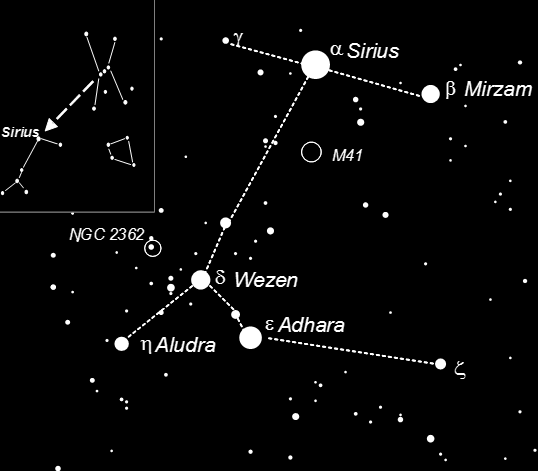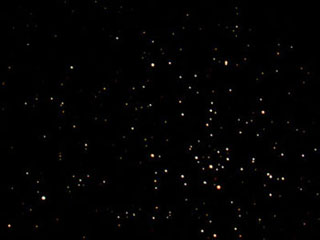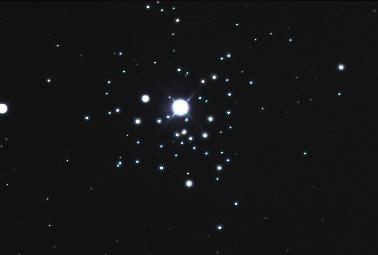Canis Major
The best months for seeing Canis Major, (the Great Dog) in the evening sky are January & February. The constellation is easily found by using the belt stars of Orion as a signpost. Following the line of these three down to the left leads to a brilliant white star. This is Sirius, the brightest star in the heavens at magnitude -1.46.
Sirius, also known as the “Dog Star”, owes its brightness to its proximity. At 8.6 light years, it is the third closest star system to us after Alpha Centauri and Barnard’s Star. Sirius is in fact a very average main sequence star which outputs a mere 23 times the visual light of our own Sun. Its surface temperature is almost 4,000OK higher than the Sun’s at 9,600OK. Sirius is a double star. As long ago as the 1840’s Friedrich Bessel detected a slight “wobble” in its tiny proper motion across the sky, implying gravitational interaction with an unseen companion. The faint secondary Sirius B, or “The Pup” was eventually imaged through a telescope for the first time by Alvan Clark in 1862. The Pup is a “white dwarf”, a type of star that has exhausted its hydrogen fuel and collapsed down into a very dense state. Just a spoonful of the degenerate matter from Sirius B would weigh several tons.
As well as the brightest first magnitude star, Canis Major also possesses the brightest second magnitude star in the heavens. This is Adhara, one of a group of three second magnitude stars at the southern end of the constellation which are known as “The Virgins”. Unfortunately Adhara never climbs more than about 9 degrees above the horizon at our latitude. Canis Major has one more second magnitude star, Mirzam, which is the most famous example of a special type of pulsating variable known as the “Beta Canis Majoris” variables after Mirzam’s Bayer designation. All four of these second magnitude stars lie at much greater distances from us than Sirius and are far more intrinsically luminous. Wezen is the most powerful. Shining from a distance of about 2,000 light years this star probably produces about 60,000 times the light of our Sun.
Lying in the direction of the winter Milky Way, Canis Major is rich in open clusters. The most famous of these is M41, a few degrees south of Sirius. At fourth magnitude, this large cluster is visible to the naked eye and has been known about since ancient times. As with the rest of the constellation it is too far south to be seen at its best from the UK, but nevertheless it is a fine sight through a telescope or even binoculars. Another excellent cluster for telescopes is NGC 2362, which surrounds the star Tau Canis Majoris. If as is suspected, Tau is a true member of this cluster it must be another extremely luminous star since NGC 2362 lies several thousand light years away.

M41

NGC_2362